
Louvre-Tuileries: The Heart of Parisian Elegance and Artistry
Discover the Louvre-Tuileries neighborhood in Paris: a blend of world-class art, serene gardens, historic landmarks, and vibrant shopping experiences.
Nestled in the very heart of Paris, the Louvre-Tuileries neighborhood offers an enchanting blend of culture, history, and natural beauty. This area is home to the world-renowned Louvre Museum, where art aficionados can lose themselves among masterpieces like the Mona Lisa and the Venus de Milo. The museum itself is a historic landmark, with its iconic glass pyramid entrance that has become a symbol of Paris. Just a stone's throw away from the Louvre lies the Tuileries Garden, a lush green space perfect for a leisurely stroll or a relaxing afternoon picnic. With its manicured lawns, picturesque fountains, and statues, the garden provides a serene escape from the bustling city streets. As you wander through the Tuileries, you'll find charming cafés and ice cream stands, ideal for a quick refreshment. The neighborhood is also a shopper's paradise, with the Rue de Rivoli offering a diverse mix of high-end boutiques, souvenir shops, and trendy stores. For those interested in a touch of history, the nearby Palais Royal and its beautiful courtyard are not to be missed. Whether you're an art lover, a history buff, or simply looking to soak in the quintessential Parisian atmosphere, the Louvre-Tuileries neighborhood promises a memorable experience.
Local tips in Louvre-Tuileries
- Visit the Louvre Museum early in the morning to avoid the crowds and enjoy a quieter experience.
- Take a break at Café Marly, located in the Louvre, for a coffee with a view of the pyramid.
- Explore the Tuileries Garden in the late afternoon when the light is perfect for photography.
- Don't miss the Palais Royal's hidden garden and its unique black-and-white striped columns.
- Wear comfortable walking shoes as the neighborhood is best explored on foot.
Louvre-Tuileries: The Heart of Parisian Elegance and Artistry
Nestled in the very heart of Paris, the Louvre-Tuileries neighborhood offers an enchanting blend of culture, history, and natural beauty. This area is home to the world-renowned Louvre Museum, where art aficionados can lose themselves among masterpieces like the Mona Lisa and the Venus de Milo. The museum itself is a historic landmark, with its iconic glass pyramid entrance that has become a symbol of Paris. Just a stone's throw away from the Louvre lies the Tuileries Garden, a lush green space perfect for a leisurely stroll or a relaxing afternoon picnic. With its manicured lawns, picturesque fountains, and statues, the garden provides a serene escape from the bustling city streets. As you wander through the Tuileries, you'll find charming cafés and ice cream stands, ideal for a quick refreshment. The neighborhood is also a shopper's paradise, with the Rue de Rivoli offering a diverse mix of high-end boutiques, souvenir shops, and trendy stores. For those interested in a touch of history, the nearby Palais Royal and its beautiful courtyard are not to be missed. Whether you're an art lover, a history buff, or simply looking to soak in the quintessential Parisian atmosphere, the Louvre-Tuileries neighborhood promises a memorable experience.
Iconic landmarks you can’t miss
Louvre Museum
Explore the art and history of the Louvre Museum, home to iconic masterpieces like the Mona Lisa, in the heart of Paris.

Tuileries Garden
Discover the enchanting Tuileries Garden: a serene oasis of art, culture, and nature in the heart of Paris, perfect for relaxation and exploration.

Louvre Pyramid
Discover the grandeur of the Louvre Pyramid, a cultural landmark and gateway to one of the world's most prestigious art museums in the heart of Paris.

Musée de l'Orangerie
Explore the masterpieces of Impressionism at Musée de l'Orangerie, a serene art haven in the heart of Paris, showcasing Monet's iconic Water Lilies.

Arc de Triomphe du Carrousel
Discover the beauty and history of the Arc de Triomphe du Carrousel, a magnificent monument in Paris, celebrating Napoleon's victories and offering stunning views of the Louvre.

Piramide Invertida
Explore the Piramide Invertida, a stunning cultural center in Paris where modern architecture meets vibrant artistic expression, providing an unforgettable experience.

Porte des Lions
Experience the artistic elegance of Porte des Lions, a historical landmark in Paris that showcases the beauty of French Renaissance architecture.

Musée du Louvre - Département des Antiquités Orientales
Explore the ancient treasures of the world at the Musée du Louvre's Département des Antiquités Orientales, a must-visit for culture enthusiasts in Paris.

Jardin du Carrousel
Discover the serene charm of Jardin du Carrousel, a tranquil oasis in Paris filled with lush gardens and stunning sculptures.

Colonnade de Perrault
Explore the Colonnade de Perrault: A Masterpiece of Classical Architecture and a Historical Landmark in the Heart of Paris.

Société des Amis du Louvre
Discover the rich cultural heritage of Paris at Société des Amis du Louvre, where art, history, and unique experiences await every visitor.

Grand Bassin Rond
Explore the enchanting Grand Bassin Rond in Paris, a historical landmark that blends serene beauty with rich architectural heritage in the heart of the city.

Monument a Pierre Marie René Ernest Waldeck-Rousseau
Discover the Monument a Pierre Marie René Ernest Waldeck-Rousseau in Paris, a historical tribute that captures the essence of French heritage and artistry.

Monument à Charles Perrault
Explore the Monument à Charles Perrault, a stunning sculpture in Paris celebrating the legacy of fairy tales and French literary heritage.

1st Arrondissement - Louvre
Experience the essence of Paris at a charming café in the 1st Arrondissement - Louvre, perfect for coffee lovers and art enthusiasts alike.

Unmissable attractions to see
Louvre Museum
Explore the Louvre Museum, home to the Mona Lisa and countless masterpieces that narrate the history of art across cultures and time.

Louvre Pyramid
Explore the Louvre Pyramid, a stunning architectural marvel and gateway to the world's greatest art collections in the heart of Paris.
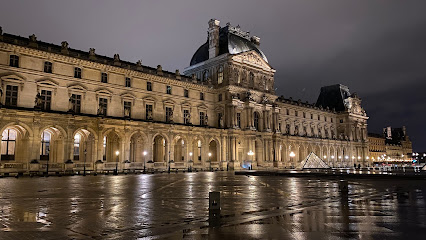
Domaine National du Palais-Royal
Discover the elegance and history of the Domaine National du Palais-Royal, a cultural landmark in the heart of Paris, adorned with beautiful gardens and art.

Jardin du Carrousel
Explore the serene beauty of Jardin du Carrousel, a hidden gem in Paris that blends nature, art, and history for an unforgettable experience.

Tunnel des Tuileries [réservé aux piétons et aux cyclistes]
Discover the serene beauty of Tunnel des Tuileries, a pedestrian haven connecting Paris's iconic landmarks with lush garden views.
![Tunnel des Tuileries [réservé aux piétons et aux cyclistes]](https://evendo-location-media.s3.amazonaws.com/AttractionImages/c0980e84-ce66-4cb4-9ecb-b774814a3368)
Victoire de Samothrace
Discover the breathtaking Winged Victory of Samothrace at the Louvre, an iconic symbol of victory and ancient Greek artistry that enchants all who visit.

La Roue de Paris
Discover Paris like never before on La Roue de Paris, offering stunning views of the city’s iconic landmarks from above.

Christmas decor
Discover the enchanting Christmas decor in Paris, where twinkling lights and festive displays create a magical holiday atmosphere.

Statue Jules Cesar
Explore the Statue of Jules César in Paris: A historic monument celebrating Roman heritage amidst vibrant city life.

Essential places to dine
Le Café Marly
Experience exquisite modern French cuisine at Le Café Marly, offering stunning views of the Louvre in an elegant Parisian setting.

Le Musset
Discover the charm of authentic French cuisine at Le Musset, where culinary excellence meets Parisian elegance.

Loulou Restaurant Paris
Discover Loulou Restaurant in Paris - where Italian tradition meets French sophistication amidst stunning views.

inavoué restaurant
Discover Inavoué: Where Traditional French Cuisine Meets Modern Elegance in the Heart of Paris.

Café de Paris
Experience authentic French cuisine at Café de Paris - where tradition meets elegance in the heart of Paris.

Le Louvre Ripaille
Experience the best of French cuisine at Le Louvre Ripaille - A delightful bistro offering exquisite dishes and fine wines in the heart of Paris.

Brasserie du Louvre - Bocuse
Experience the heart of French cuisine and local brewing at Brasserie du Louvre - Bocuse in Paris.

L'Ardoise
Experience authentic French cuisine at L'Ardoise in Paris, where traditional flavors meet modern bistro charm.

Bistrot Benoit
Experience authentic French cuisine at Bistrot Benoit, nestled in the iconic Hall Napoléon at the Louvre—perfect for families and tourists seeking tradition.

Le Comptoir du Louvre - Paul
Experience authentic French flavors at Le Comptoir du Louvre - Paul inside the iconic Musée du Louvre, perfect for art lovers and foodies alike.

Markets, malls and hidden boutiques
Carrousel du Louvre
Discover the luxurious shopping experience at Carrousel du Louvre, an architectural marvel in the heart of Paris, blending culture, cuisine, and couture.

Astier de Villatte
Explore the artisanal charm of Astier de Villatte, where exquisite chinaware, candles, and unique decor come together in the heart of Paris.

Librairie-Boutique du Musée du Louvre
Explore the Librairie-Boutique du Musée du Louvre for a unique selection of books, art-inspired gifts, and souvenirs in the heart of Paris.
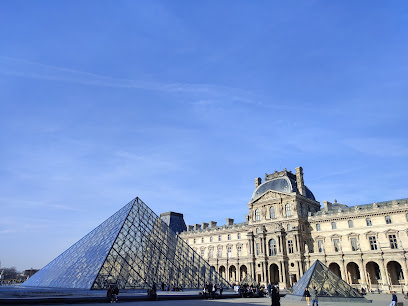
Pylones
Explore Pylones, a whimsical gift shop in Paris offering unique souvenirs, fashion accessories, and home decor that embody French creativity.

Boutique Officielle Paris 2024 Carrousel du Louvre
Explore a treasure trove of authentic Parisian souvenirs at the Boutique Officielle, nestled within the iconic Carrousel du Louvre.

Sandro
Explore Sandro, a premier destination for contemporary fashion in Paris, offering stylish clothing, accessories, and a chic shopping experience.

La Suvina - Souvenirs De Paris
Discover exquisite souvenirs and artisanal gifts at La Suvina, a charming gift shop in the heart of Paris capturing the city's essence.

Souvenirs Center
Discover the essence of Paris at the Souvenir Center, where unique keepsakes and local craftsmanship await every traveler.

FOROH SOUVENIRS
Explore Foroh Souvenirs for unique, handcrafted gifts reflecting the charm and artistry of Paris, located near the iconic Louvre Museum.
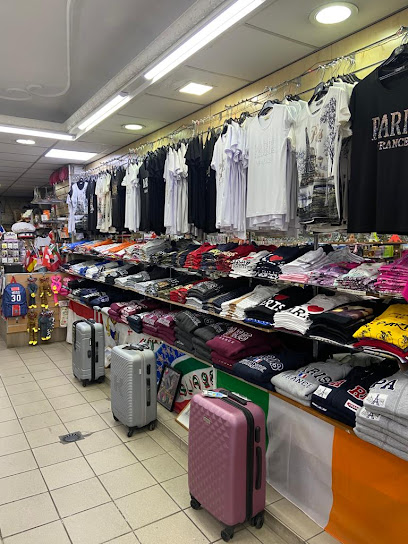
Aux Tuileries
Discover exquisite fashion accessories at Aux Tuileries, the heart of Parisian style and elegance.

Essential bars & hidden hideouts
Le Café Marly
Discover the perfect blend of modern French cuisine and iconic views at Le Café Marly, a culinary gem near the Louvre in Paris.

Le Fumoir
Discover the heart of Paris at Le Fumoir, a delightful blend of French cuisine, a lively cocktail bar, and a charming tea house.

Le Musset
Experience the heart of Parisian gastronomy at Le Musset, where exquisite French cuisine meets a vibrant bar atmosphere.

Velvet Bar Paris
Experience the essence of Parisian nightlife at Velvet Bar, where exquisite cocktails meet stylish ambiance in the city's vibrant heart.

Le Louvre Ripaille
Discover the culinary delights of Le Louvre Ripaille, a charming bistro and wine bar in the heart of Paris, perfect for savoring authentic French cuisine.
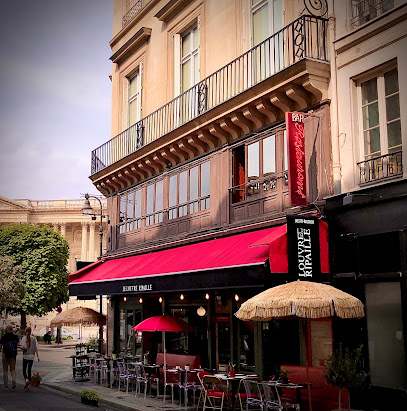
Officine du Louvre
Experience refined relaxation at Officine du Louvre, a chic cocktail and wine bar in the heart of Paris, perfect for unwinding after exploring the city.

Au Petit Bar
Discover Au Petit Bar: A quintessential Parisian bar offering a cozy ambiance, delightful drinks, and a taste of authentic local culture.

Bar 8
Discover the elegance of Bar 8 in Paris, where exquisite tapas and signature cocktails meet a chic, relaxed atmosphere at the Mandarin Oriental.
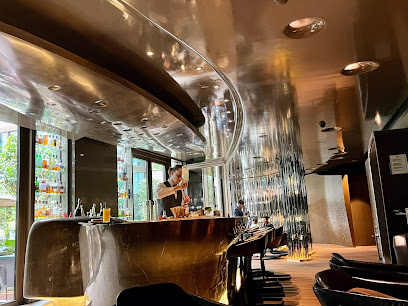
Bar Tuileries
Experience the elegance of Paris at Bar Tuileries, a cozy bar offering exquisite drinks and delightful ambiance in the city's heart.

Bar Lumen
Indulge in exquisite cocktails at Bar Lumen, a stylish cocktail bar in the heart of Paris, perfect for an unforgettable evening.

Local Phrases
-
- HelloBonjour
[bohn-zhoor] - GoodbyeAu revoir
[oh ruh-vwahr] - YesOui
[wee] - NoNon
[nohn] - Please/You're welcomeS'il vous plaît/De rien
[seel voo pleh/duh ryen] - Thank youMerci
[mehr-see] - Excuse me/SorryExcusez-moi/Désolé
[ehk-skew-zay mwah/dey-zoh-lay] - How are you?Comment ça va?
[koh-mohn sah vah] - Fine. And you?Bien. Et vous?
[byen. ey voo] - Do you speak English?Parlez-vous anglais?
[par-lay voo ahn-glay] - I don't understandJe ne comprends pas
[zhuh nuh kohm-prahnd pah]
- HelloBonjour
-
- I'd like to see the menu, pleaseJe voudrais voir la carte, s'il vous plaît
[zhuh voo-dray vwahr lah kart, seel voo pleh] - I don't eat meatJe ne mange pas de viande
[zhuh nuh mahnj pah duh vyand] - Cheers!Santé!
[sahn-tay] - I would like to pay, pleaseJe voudrais payer, s'il vous plaît
[zhuh voo-dray pay-yay, seel voo pleh]
- I'd like to see the menu, pleaseJe voudrais voir la carte, s'il vous plaît
-
- Help!Au secours!
[oh suh-koor] - Go away!Allez-vous en!
[ah-lay vooz ahn] - Call the Police!Appelez la police!
[ah-peh-lay lah poh-lees] - Call a doctor!Appelez un médecin!
[ah-peh-lay uh may-duh-sahn] - I'm lostJe suis perdu(e)
[zhuh swee pair-doo] - I'm illJe suis malade
[zhuh swee mah-lahd]
- Help!Au secours!
-
- I'd like to buy...Je voudrais acheter...
[zhuh voo-dray zheh-tey...] - I'm just lookingJe regarde juste
[zhuh ruh-gahrd zheust] - How much is it?Combien ça coûte?
[kohm-byen sah koot] - That's too expensiveC'est trop cher
[seh troh sher] - Can you lower the price?Pouvez-vous baisser le prix?
[poo-veh voo beh-say luh pree]
- I'd like to buy...Je voudrais acheter...
-
- What time is it?Quelle heure est-il?
[kehl uhr eh-teel] - It's one o'clockIl est une heure
[eel eh oon uhr] - Half past (10)Dix heures et demie
[dees uhr eh duh-mee] - MorningMatin
[mah-tahn] - AfternoonAprès-midi
[ah-pray mee-dee] - EveningSoir
[swahr] - YesterdayHier
[yehr] - TodayAujourd'hui
[oh-zhoor-dwee] - TomorrowDemain
[duh-mahn] - 1Un
[uh] - 2Deux
[duh] - 3Trois
[twah] - 4Quatre
[kat] - 5Cinq
[sank] - 6Six
[sees] - 7Sept
[sett] - 8Huit
[weet] - 9Neuf
[nuff] - 10Dix
[dees]
- What time is it?Quelle heure est-il?
-
- Where's a/the...?Où est...?
[oo eh...] - What's the address?Quelle est l'adresse?
[kehl eh lah-dress] - Can you show me (on the map)?Pouvez-vous me montrer (sur la carte)?
[poo-veh voo muh mohn-tray (soor lah kart)] - When's the next (bus)?Quand est le prochain (bus)?
[kahnd eh luh proh-shang (boos)] - A ticket (to ....)Un billet (pour ....)
[uhn bee-yay (poor)]
- Where's a/the...?Où est...?
History of Louvre-Tuileries
-
The Louvre began as a fortress built by King Philip II in the late 12th century to defend Paris from potential invaders. Over the centuries, it evolved into a royal palace, reflecting the architectural styles of the eras, from medieval stone to Renaissance grandeur. The transformation of the Louvre into a museum in 1793 marked a significant shift, making it a cultural landmark that housed an extensive collection of art and historical artifacts.
-
The Tuileries Garden was created in the early 16th century at the behest of Catherine de' Medici, who built the Tuileries Palace as a royal residence adjacent to the garden. Designed by landscape architect André Le Nôtre, the garden became a public space after the French Revolution, symbolizing the accessibility of nature and beauty to all citizens. It has served as a backdrop for numerous historical events, including the French Revolution and the Paris Commune.
-
During the French Revolution, the Louvre was repurposed as a public museum, a radical idea at the time. The revolutionary government aimed to make art accessible to the masses, leading to the collection of art pieces from royal collections and private estates. This shift not only democratized art but also reinforced the Louvre's status as a cornerstone of French cultural identity.
-
Napoleon Bonaparte, recognizing the Louvre's significance, expanded the museum and commissioned the construction of the iconic glass pyramid entrance in the late 20th century. Under his reign, the museum acquired numerous artworks from across Europe, emphasizing France's cultural dominance. The expansion of the museum's collection continued to shape Paris as a global art capital.
-
In the 20th and 21st centuries, the Louvre-Tuileries area has evolved into a vibrant cultural hub. The introduction of contemporary art exhibitions and events, along with the establishment of new galleries, has created a dynamic environment that attracts visitors from around the world. The Louvre remains a focal point of Parisian life, embodying the city's rich history and cultural heritage.
Louvre-Tuileries Essentials
-
Louvre-Tuileries is centrally located in Paris, making it easily accessible from other neighbourhoods. The nearest metro stations are Palais Royal - Musée du Louvre (Line 1 and 7) and Tuileries (Line 1). You can also reach the area via the RER trains, with the closest station being Châtelet - Les Halles. Buses 21, 27, 39, and 68 serve the area as well. If you are arriving from Charles de Gaulle Airport, take the RER B train to Châtelet - Les Halles, then transfer to Line 1.
-
Louvre-Tuileries is a pedestrian-friendly area, and many attractions are within walking distance. The Paris Métro is efficient, with Line 1 running through the neighbourhood. Bicycles are also a popular mode of transport, with Vélib' bike-sharing stations available throughout the area. Buses are another convenient option, with multiple lines serving the vicinity. Taxis and rideshare services like Uber are readily available for quicker travel.
-
Louvre-Tuileries is generally safe for tourists, but standard precautions should be taken. Keep an eye on your belongings in crowded areas, especially around major attractions like the Louvre and Tuileries Garden. While violent crime rates are low, petty theft, including pickpocketing, can occur. Avoid secluded areas at night and be cautious in busy tourist spots.
-
In case of an emergency, dial 112 for police, fire, or medical assistance. The nearest hospitals include Hôtel-Dieu and Pitié-Salpêtrière. It’s advisable to have travel insurance that covers emergencies. Pharmacies are widely available for minor health issues, with many open on Sundays.
-
Fashion: Do dress elegantly, as Parisians appreciate style. Don't wear overly casual attire, especially when dining out. Religion: Do respect religious sites, and maintain silence in places of worship. Public Transport: Do validate your ticket before boarding. Don't engage in loud conversations or use your phone excessively. Greetings: Do greet with 'Bonjour' when entering shops. Don't forget to say 'Merci' when leaving. Eating & Drinking: Do enjoy café culture and try local pastries. Don't eat while walking, as it is generally frowned upon in Paris.
-
To experience Louvre-Tuileries like a local, visit the lesser-known cafés and bistros tucked away in side streets. Participate in a picnic in the Tuileries Garden, where locals often gather. Attend free exhibitions at the Petit Palais, and be sure to explore the nearby Palais Royal for its beautiful gardens and shops. Engage with local vendors in the market at Rue de Rivoli, especially on weekends when the atmosphere is lively.
-
When interacting with locals, it's important to be polite. Always start conversations with 'Bonjour' and maintain eye contact. It's customary to greet shopkeepers upon entering and thank them when leaving. Tipping is appreciated but not mandatory; rounding up the bill or leaving small change is common. If you are dining, wait for the host to invite you to sit before taking a seat.
Trending Landmarks in Louvre-Tuileries
-
Louvre Museum
-
Tuileries Garden
-
Louvre Pyramid
-
Musée de l'Orangerie
-
Arc de Triomphe du Carrousel
-
Piramide Invertida
-
Porte des Lions
-
Musée du Louvre - Département des Antiquités Orientales
-
Jardin du Carrousel
-
Colonnade de Perrault
-
Société des Amis du Louvre
-
Grand Bassin Rond
-
Monument a Pierre Marie René Ernest Waldeck-Rousseau
-
Monument à Charles Perrault
-
1st Arrondissement - Louvre
Nearby Cities to Louvre-Tuileries
-
Things To Do in Versailles
-
Things To Do in Rouen
-
Things To Do in Amiens
-
Things To Do in Reims
-
Things To Do in Caen
-
Things To Do in Lille
-
Things To Do in Tours
-
Things To Do in Tournai
-
Things To Do in Mons
-
Things To Do in Ypres
-
Things To Do in Kortrijk
-
Things To Do in Dinant
-
Things To Do in Namur
-
Things To Do in Nieuwpoort
-
Things To Do in Louvain-la-Neuve










